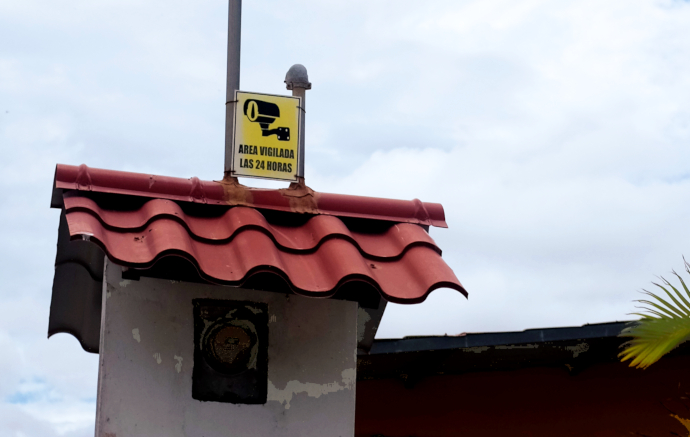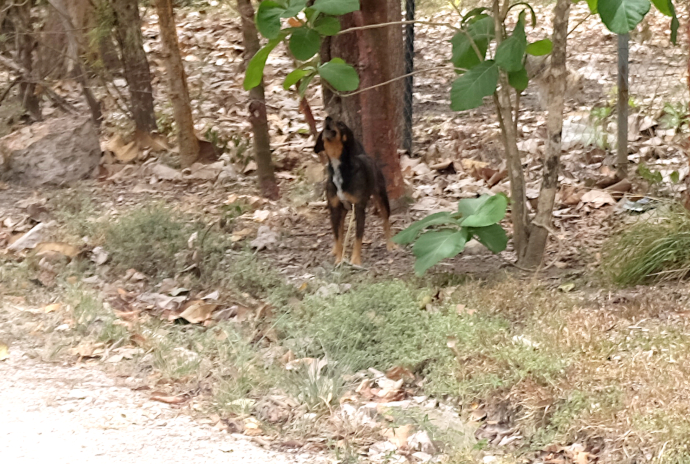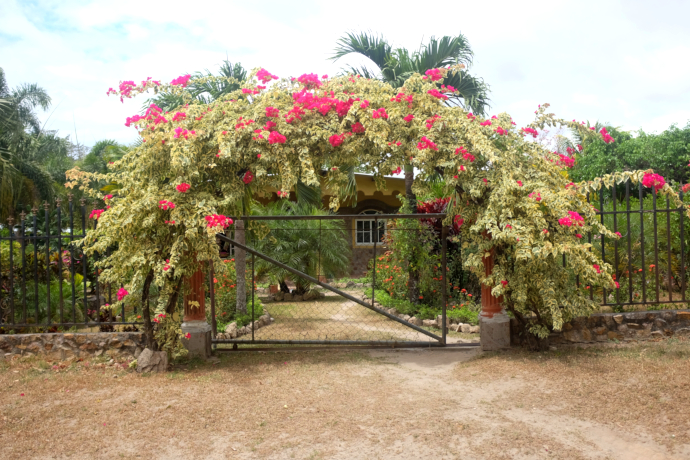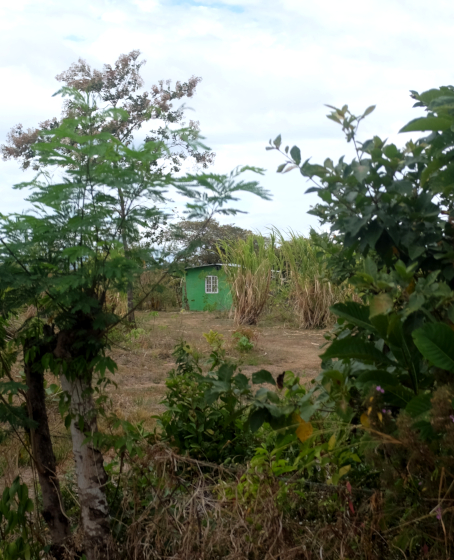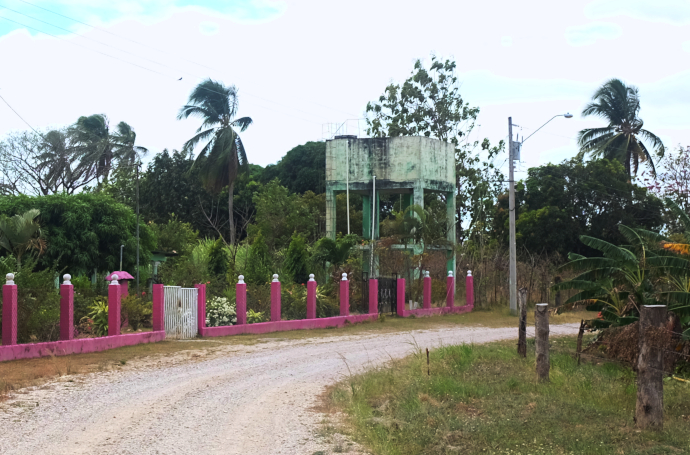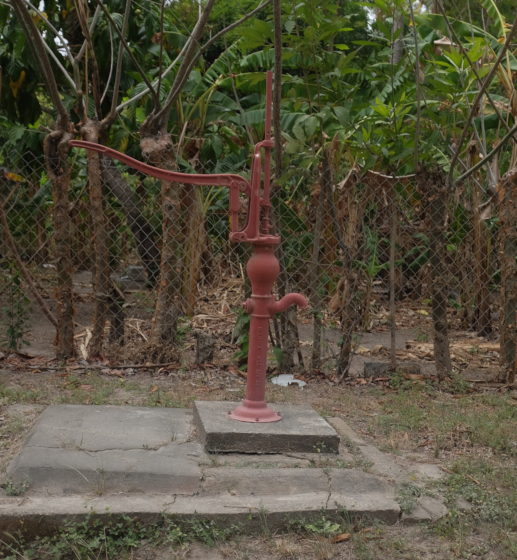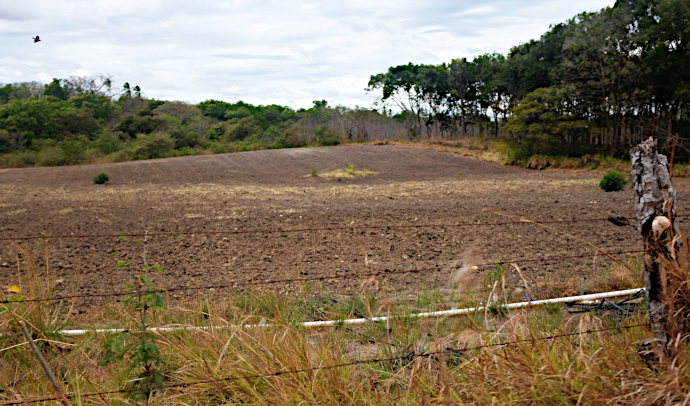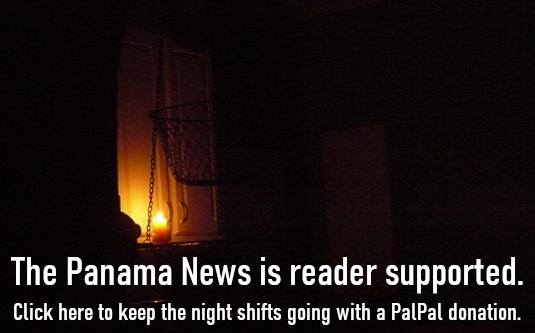It was the first time I have seen one of these in the neighborhood, outside one of the better homes but not really the most opulent. And the first photo on my walk of little more than one hour, close by my house. Nearby an apparently unoccupied but not abandoned house bore the signs of the sort of crime that was visited on me and some of my close neighbors — breeze blocks smashed in to gain entry, on the side of a house. Easy getaway, one or more accomplices as lookouts.
Named for a geographical feature,
with this stereotypical reputation
photo story by Eric Jackson, near where he lives
Go up to the topographical top of Cocle provinces vast Anton municipal district and you will be on the rim of an old volcanic crater and farther up to La India Dormida and the mountains beyond. But the corregimiento of Juan Diaz de Anton is at the foot of the foothills. Go past the elementary school and road turns to a slightly upward grade, getting a bit steeper en route to San Juan de Dios and then Altos de La Estancia. But take a left into a drop perhaps a mile before the school and you get onto an unpaved street with no marked name, sometimes referred to as Via El Bajito, sometimes a Via a San Juan de Dios. The first times I walked its entire length it took me a little under an hour. This time, the first time in a year and a half, it took a little more than an hour.
It’s five or six kilometers, no steep parts, little traffic, no buses and only a few tiny businesses. With neither zoning laws nor some developer who has put in an urbanizacion or condo tower, it’s reasonably quiet and home to some poor folks and some richer ones. From time to time over the years there have been little crime waves, and that, or when the local residents go down to the Pan-American Highway at the back entrance to the neighborhood and block traffic to demand a layer of asphalt, is when El Bajito attracts a bit of attention from some of the rabiblanco media.
Crime and the resistance
So what’s the crime scene really like? Is one of the nicer homes the lair of some wealthy underworld kingpin, laying low in an inconspicuous place? Perhaps, but I’m not one of these guys to approach my neighbor and ask him if he’s a gangster. That said, I think that some of the better off folks are in El Bajito in large part because they want to live away from the attention and the traffic.
But there are some visible clues about the crime scene, some of which were not there a couple of months in the epidemic when I walked the road in 2020.
I counted three obviously smashed-into homes. There may be more, which have been neatly repaired. Then there was the surveillance video and the sign announcing its presence. There were all closer to my home than to the Pan-American Highway end of the road.
But another thing that I noticed a few months into the epidemic was missing as such. But maybe not entirely. Back then, I ran across several emaciated, apparently abandoned dogs wandering. None of that this time. But a bunch of people, relatively rich and relatively poor, maintain dog packs now. A couple of such packs came out to challenge me, and one ferocious young white male with brown spots gave me a nip. (No broken skin, nor torn pants.) The confrontational stance and yelled “HEY!” backed these guys off, and then a man came out of the house from the yard of which they emerged and the four canines slunk back from the road. I got a sheepish look from the guy, but I was laughing.
I think that notwithstanding one rambunctious guardian, this is one of the kind citizens who has taken in dogs that were fending for themselves in mid-2020. Crime has given people the extra reason to take in outcast dogs.
A running dog, or possessed of commie vanguard politics? This guy came out of a yard to bark, and as I walked by walked in the opposite direction. When three dogs appeared in front of me to reinforce, he moved in from behind. Instinctive dog pack tactics. I stood my ground and wagged my finger, which caused the foursome to retreat. This lady came out of the house and we both laughed at the dog pack that she feeds.
The economy
There are hardscrabble zinc shacks going up, half-destroyed casas de quincha being added to with materials that don’t match, starts on modest little cinderblock homes, little houses that have been painted since last I looked. Some of these will be woeful stories, of jobs or businesses lost in the city. But these are economic activities with an eye toward the future.
There is housing construction that’s not all that modest. There are the joron, the kiosko and the fonda that are ready to do business when the fear, regulations and poverty start to lift. And then there are all these homes with beautiful tended gardens. Perhaps some of them are owner-tended, but mostly, there are people being hired to do this work. Ever so slowly, there is economic activity returning that was not so much in evidence when the epidemic’s first Panama wave was receding.
Not a mansion, slightly upscale for El Bajito — and surely somebody has a gardening job.
A fresh coat of paint on a little house set back from the road suggests that someone is optimistic enough to look good for the future.
Water
I was getting sprinkled upon off and on during my walk. The city forecast was a few days of possible thunderstorms, but El Bajito is closer to the beach than the mountains, part of the coastal lowlands along the western fringe of the Gulf of Panama known as the Dry Arc. Not nearly so rainy as where I grew up on the Atlantic Side. Not as rainy as the capital, either.
I knew the forecast, saw the clouds and did not take an umbrella. I did however, put some plastic bags in the chacara in case I needed to protect the camera, notebook and so on from rain.
An Ash Wednesday miracle? Not especially. Climate change? Perhaps. It’s early in March for significant rain. After my walk I went to the caseta across the highway and grabbed a ride into Anton, there to get cat food, dog bones, a junk food fix and a hard copy of La Prensa, then a ride back to my usual stop at the entrance to El Bajito. It was raining more substantially when I got to the town of Anton.
I welcomed the early rain. My garden stood up and cheered. Transplanting and planting draw nigh, and new trellises for vines to climb. I will need a new hoe at the top of my meager tool buying budget. I would not be surprised to get the year’s first beans sometime in the next couple of weeks.
It’s prohibited to use water from the local aqueduct system for irrigation. I think they’d come down about lawn sprinklers, but a water can to keep the herb bushes alive during the drought seems to be off their radar. I am in arrears with the water committee — like so many of my neighbors — and will need to take care of that shortly. There is a work option in these hard times, but I’m this 69-year-old arthritic buzzard. Leave it to the youngsters.
There is water rationing of a sort — like maybe only a part of a tank comes per week in the dry months — but this year there has been no long outage. The job is being done. Maybe not as decoratively as it could be, but the system is functioning.
These sorts of water towers are not so much to store water as to keep the water pressure viable along the system’s thin PVC pipes. Were it up to me, I’d repaint this tower and turn an artist loose on it to give the neighborhood a more distinctive landmark. The norm in too many places is to put the representante’s name on it. It really would not fit with this neighborhood, part of a PRD corregimiento but an often ignored and dissident area.
Before the aqueduct there were neighborhood pumps. This one still works.
The larger economy
Does ANYONE in El Bajito have a bank loan? Surely, here or there, for this or that. But generally you can’t insure a home in the Interior, outside of the principal towns. Land tenure has been dicey in much of Cocle since the terrible devastation and depopulation of the 1899-1902 Thousand Days War. Most of El Bajito’s homes are held by rights of possession and even with respect to titled property land grabbing is a thing here.
And yet…. What’s that big white agricultural tent off in the distance, deeper into the hollow? And what are they going to grow in that large, recently plowed, field near the highway end of the road?
We are talking cash crops here, not just subsistence farming like on my 900 square meters. The banks, private but more often public, do finance such activities. With high food prices it would be more of a sure-fire investment, but for the high prices of fuel and agro-chemicals and other inputs. But the rains are coming and the neighborhood is about to get some agribusiness going for another season.
From a hawk’s perspective, an agricultural field holds the prospect of a tasty rodent nibbling on the seeds and then crops. Wildlife has its economies too.
Contact us by email at fund4thepanamanews@gmail.com
To fend off hackers, organized trolls and other online vandalism, our website comments feature is switched off. Instead, come to our Facebook page to join in the discussion.
These links are interactive — click on the boxes

